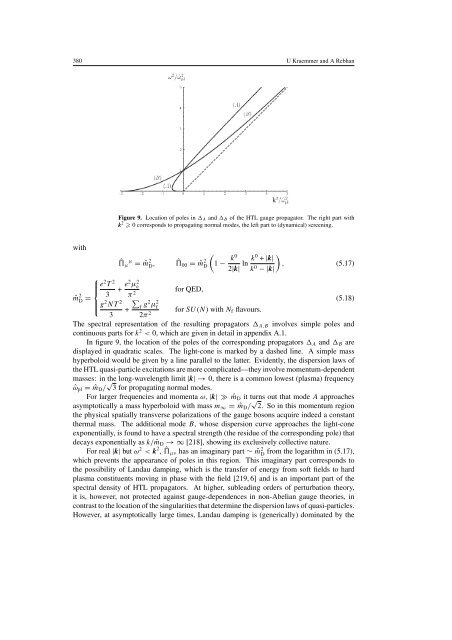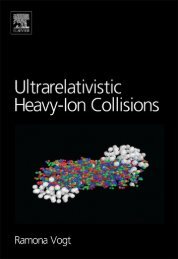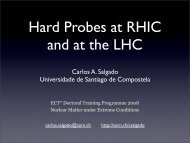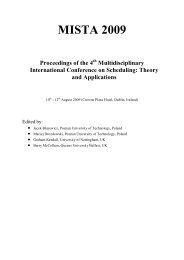Advances in perturbative thermal field theory - Ultra-relativistic ...
Advances in perturbative thermal field theory - Ultra-relativistic ...
Advances in perturbative thermal field theory - Ultra-relativistic ...
You also want an ePaper? Increase the reach of your titles
YUMPU automatically turns print PDFs into web optimized ePapers that Google loves.
380 U Kraemmer and A Rebhan<br />
Figure 9. Location of poles <strong>in</strong> A and B of the HTL gauge propagator. The right part with<br />
k 2 0 corresponds to propagat<strong>in</strong>g normal modes, the left part to (dynamical) screen<strong>in</strong>g.<br />
with<br />
ˆ µ µ = ˆm 2 D ,<br />
ˆ 00 = ˆm 2 D<br />
)<br />
(1 − k0<br />
2|k| ln k0 + |k|<br />
, (5.17)<br />
k 0 −|k|<br />
⎧⎪<br />
e 2 T 2<br />
⎨ + e2 µ 2 e<br />
for QED,<br />
ˆm 2 D = 3 π 2<br />
⎪ ⎩<br />
g 2 NT 2 ∑<br />
(5.18)<br />
f<br />
+<br />
g2 µ 2 f<br />
for SU(N) with N<br />
3 2π 2<br />
f flavours.<br />
The spectral representation of the result<strong>in</strong>g propagators A,B <strong>in</strong>volves simple poles and<br />
cont<strong>in</strong>uous parts for k 2 < 0, which are given <strong>in</strong> detail <strong>in</strong> appendix A.1.<br />
In figure 9, the location of the poles of the correspond<strong>in</strong>g propagators A and B are<br />
displayed <strong>in</strong> quadratic scales. The light-cone is marked by a dashed l<strong>in</strong>e. A simple mass<br />
hyperboloid would be given by a l<strong>in</strong>e parallel to the latter. Evidently, the dispersion laws of<br />
the HTL quasi-particle excitations are more complicated—they <strong>in</strong>volve momentum-dependent<br />
masses: <strong>in</strong> the long-wavelength limit |k| →0, there is a common lowest (plasma) frequency<br />
ˆω pl = ˆm D / √ 3 for propagat<strong>in</strong>g normal modes.<br />
For larger frequencies and momenta ω,|k| ≫ ˆm D it turns out that mode A approaches<br />
asymptotically a mass hyperboloid with mass m ∞ = ˆm D / √ 2. So <strong>in</strong> this momentum region<br />
the physical spatially transverse polarizations of the gauge bosons acquire <strong>in</strong>deed a constant<br />
<strong>thermal</strong> mass. The additional mode B, whose dispersion curve approaches the light-cone<br />
exponentially, is found to have a spectral strength (the residue of the correspond<strong>in</strong>g pole) that<br />
decays exponentially as k/ ˆm D →∞[218], show<strong>in</strong>g its exclusively collective nature.<br />
For real |k| but ω 2 < k 2 , ˆ µν has an imag<strong>in</strong>ary part ∼ ˆm 2 D from the logarithm <strong>in</strong> (5.17),<br />
which prevents the appearance of poles <strong>in</strong> this region. This imag<strong>in</strong>ary part corresponds to<br />
the possibility of Landau damp<strong>in</strong>g, which is the transfer of energy from soft <strong>field</strong>s to hard<br />
plasma constituents mov<strong>in</strong>g <strong>in</strong> phase with the <strong>field</strong> [219, 6] and is an important part of the<br />
spectral density of HTL propagators. At higher, sublead<strong>in</strong>g orders of perturbation <strong>theory</strong>,<br />
it is, however, not protected aga<strong>in</strong>st gauge-dependences <strong>in</strong> non-Abelian gauge theories, <strong>in</strong><br />
contrast to the location of the s<strong>in</strong>gularities that determ<strong>in</strong>e the dispersion laws of quasi-particles.<br />
However, at asymptotically large times, Landau damp<strong>in</strong>g is (generically) dom<strong>in</strong>ated by the







